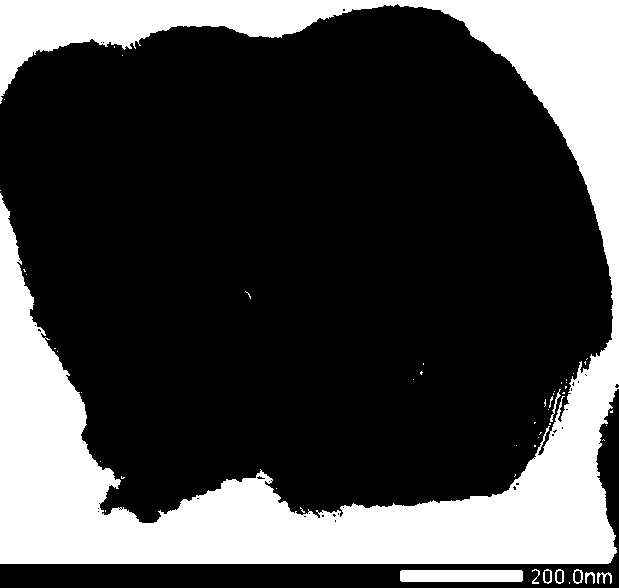Preparation method of mesoporous confinement nickel-based methane dry reforming catalyst
A nickel-based methane and catalyst technology is applied in the field of preparation of nickel-based methane dry reforming catalysts, and achieves the effects of low requirements for experimental equipment, inhibition of carbon deposition, and simple preparation process.
- Summary
- Abstract
- Description
- Claims
- Application Information
AI Technical Summary
Problems solved by technology
Method used
Image
Examples
Embodiment 1
[0021] Weigh 0.27 g nickel nitrate hexahydrate and 0.5 g SBA-15, the mass fraction of nickel is 10 wt%, nickel nitrate hexahydrate, SBA-15 and 10 mL ethylene glycol were mixed and stirred under vacuum for 24 h, and dried in vacuum. N 2 The heating rate was 1 ℃ / min under the atmosphere, the calcination was performed at 550 ℃ for 4 h, and the calcination was performed under air atmosphere for 2 h. It is then reduced by using H 2 -TPR, first pass N 2 Pretreatment at 300 °C for 30 min, cooled to room temperature with 10% H by volume 2 / N 2 The Ni / SBA-15 nanocatalyst was obtained by reducing the mixed gas (flow rate of 30 mL / min) at 800 °C for 1 h.
[0022] Test the catalytic activity of the above catalyst: Weigh 0.15 g (40-60 mesh) of the prepared catalyst and put it into a fixed-bed quartz tube reactor for catalyst performance testing. The injection volume of CH4 and CO2 is 1:1 (both flows are 15 mL / min), the activity test ranges from 450 °C to 800 °C, the catalyst has a cer...
Embodiment 2
[0024] Weigh 0.28 g nickel acetylacetonate dihydrate and 0.5 g KIT-6, the mass fraction of nickel is 10 wt%, mix nickel acetylacetonate dihydrate, KIT-6 and 10 mL glycerol under vacuum for 18 h, and dry in vacuum , N 2 The heating rate was 1 ℃ / min in the atmosphere, the calcination was performed at 600 ℃ for 4 h, and the calcination was in air atmosphere for 2 h. It is then reduced by using H 2 -TPR, first pass N 2 Pretreatment at 300 °C for 30 min, cooled to room temperature with 10% H by volume 2 / N 2 The Ni / KIT-6 nanocatalyst was obtained by reducing the mixed gas (flow rate of 30 mL / min) at 800 °C for 1 h.
[0025]Test the catalytic activity of the above catalyst: Weigh 0.15 g (40-60 mesh) of the prepared catalyst and put it into a fixed-bed quartz tube reactor for catalyst performance testing. The injection volume of CH4 and CO2 is 1:1 (both flows are 15 mL / min), the activity test ranges from 450 °C to 800 °C, the catalyst has a certain activity at 450 °C, the highes...
Embodiment 3
[0027] Weigh 0.22 g nickel chloride hexahydrate and 0.5 g MCM-41, the mass fraction of nickel is 10 wt%, and mix and stir nickel chloride hexahydrate, MCM-41 and 10 mL 1,4-butanediol under vacuum for 20 h, vacuum dried, N 2 The heating rate was 1 ℃ / min under the atmosphere, the calcination was performed at 600 ℃ for 6 h, and the calcination was performed under air atmosphere for 2 h. It is then reduced by using H 2 -TPR, first pass N 2 Pretreatment at 300 °C for 30 min, cooled to room temperature with 10% H by volume 2 / N 2 The Ni / MCM-41 nanocatalyst was obtained by reducing the mixed gas (flow rate of 30 mL / min) at 800 °C for 1 h.
[0028] Test the catalytic activity of the above catalyst: Weigh 0.15 g (40-60 mesh) of the prepared catalyst and put it into a fixed-bed quartz tube reactor for catalyst performance testing. The injection volume of CH4 and CO2 is 1:1 (both flows are 15 mL / min), the activity test ranges from 450 °C to 800 °C, the catalyst has a certain activit...
PUM
| Property | Measurement | Unit |
|---|---|---|
| size | aaaaa | aaaaa |
Abstract
Description
Claims
Application Information
 Login to View More
Login to View More - R&D Engineer
- R&D Manager
- IP Professional
- Industry Leading Data Capabilities
- Powerful AI technology
- Patent DNA Extraction
Browse by: Latest US Patents, China's latest patents, Technical Efficacy Thesaurus, Application Domain, Technology Topic, Popular Technical Reports.
© 2024 PatSnap. All rights reserved.Legal|Privacy policy|Modern Slavery Act Transparency Statement|Sitemap|About US| Contact US: help@patsnap.com








